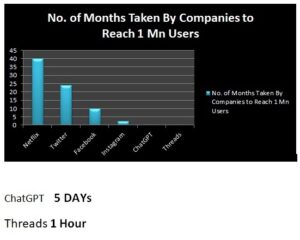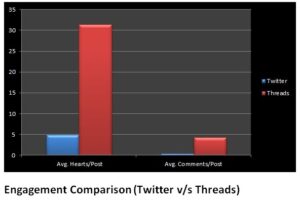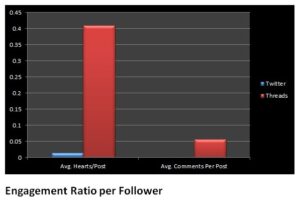Threads vs Twitter: Unveiling the Engagement Battle

The emergence of Threads, the new social networking platform by Instagram, has taken the digital world by storm. With over 100 million users within just a week, Threads has left a lasting impression as a formidable competitor to Twitter. Its rapid growth has even surprised industry experts, including Facebook itself. As marketers explore the potential of Threads, the question arises: Which platform holds the key to higher views and engagement? Let’s delve into the data and analyze the numbers.
Content Repurposing and Engagement:

When Threads initially launched, a trend emerged among users. They began repurposing their content from other social networks, particularly Twitter, for Threads. This approach is not uncommon, as content repurposing allows marketers and companies to adopt an omnichannel strategy with minimal effort. Curious to investigate the engagement levels on both platforms, we tracked 308 accounts and enlisted the marketing community’s assistance for a comprehensive analysis.
Threads Surpass in Engagement:
In the Threads vs Twitter scenario, As anticipated, Threads demonstrated higher engagement, as is often the case with new social networks seeking rapid growth. It’s important for every user to see everything, fostering a thriving network ecosystem. Eventually, engagement is tempered to increase ad revenue. In our study, which predominantly focused on marketers, Threads outshone Twitter significantly.
Likes and Comments:

In the Threads vs Twitter scenario, From the accounts we tracked, Threads generated an average of 31.4 likes (hearts) per post, while Twitter lagged behind with just 4.9 likes per post. The disparity was even more pronounced in terms of comments, with Threads achieving an average of 4.3 comments per post, compared to Twitter’s 0.4 comments per post.
Engagement per Follower:

In the Threads vs Twitter scenario, To address concerns about follower count skewing the results, we analyzed engagement per follower. Threads showcased impressive figures, with 0.41% likes per follower, whereas Twitter trailed far behind at 0.015%. The story was similar for comments, with Threads garnering 0.056% engagement per follower, while Twitter could only manage 0.001%.
The Connection Between Engagement and Reach:
Higher engagement often implies a community that is more likely to champion your company or brand, leading to increased loyalty and followings. However, it’s important to note that engagement doesn’t necessarily translate into more views. In the Threads vs Twitter scenario, Twitter provides users with visibility into their reach, whereas Threads does not, making it challenging to assess the extent of exposure and reach on the platform.
Conclusion:
The battle for engagement between Threads on Instagram and Twitter has revealed intriguing insights. Threads, with its rapid user growth, has shown significantly higher engagement rates per post and per follower. While this indicates a community more likely to support and evangelize brands, it remains unclear whether this translates into greater views and reach. As marketers navigate the dynamic landscape of social media, understanding the unique advantages and limitations of each platform becomes crucial for formulating effective strategies and leveraging the power of engagement to achieve business objectives.
You can also read about Mark’s Martial Arts Training So Far

[…] Also, read about who is winning statistically Threads vs Twitter […]